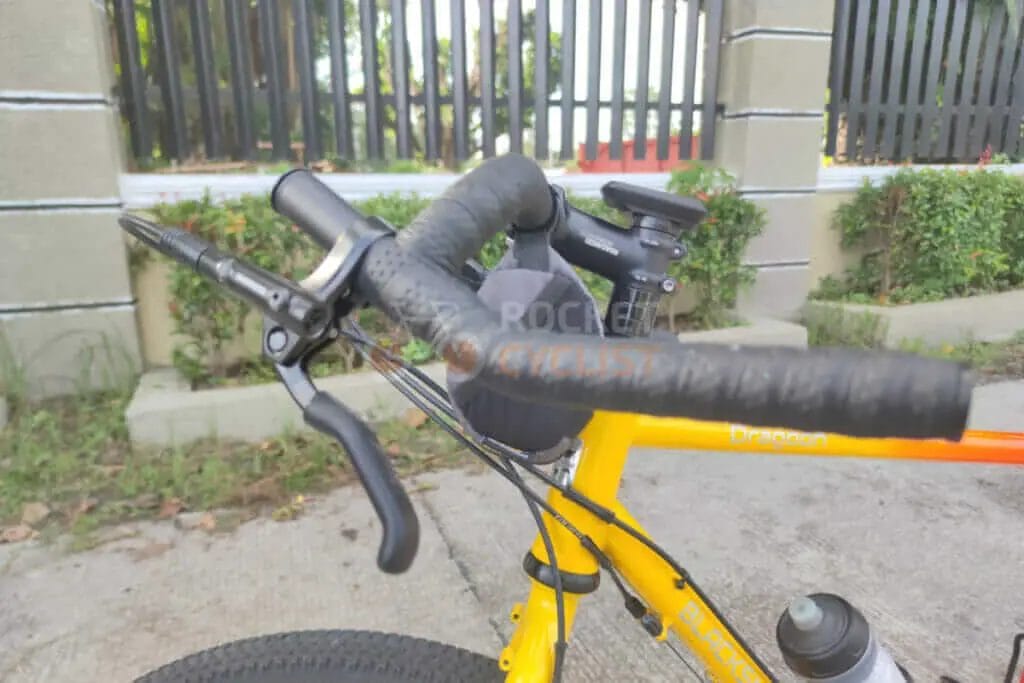Last Updated on February 11, 2024 by Vinson Lozano
The world of cycling continues to evolve with advancements in bike technology and design. One such innovation is the advent of the corner bar handlebar for bicycles. This article aims to provide an in-depth look at this type of handlebar and its benefits to cyclists.

The Importance of Handlebars in Cycling
The handlebar on a bicycle is more than just a steering wheel. It significantly impacts your total cycling experience, from your comfort level, speed, safety, to your level of control while riding. The choice of a handlebar can make or break your cycling journey. There are different types of handlebars, and each offers its set of advantages.
Corner Bar Handlebar: is an avant-garde design that provides cyclists with enhanced control and comfort. It bends at an acute angle rather than going straight across like traditional bike handlebars. This design optimizes the grip placements for a more natural and comfortable hold.
Why Choose a Corner Bar Handlebar?

The corner bar handlebar offers several benefits to cyclists. Firstly, they provide excellent comfort. The bent shape allows for a more ergonomic grip, reducing the strain on the rider’s wrists and upper body during long rides.
Secondly, they offer improved control. The positioning of the hands in alignment with the direction of travel provides superior balance and ease of maneuvering, especially during cornering.
Thirdly, corner bar handlebars are versatile. They are suitable for various kinds of cycling, including road cycling, off-roading, and BMX. Whether a professional rider or a weekend warrior, the corner bar handlebar can enhance cycling performance.
Here’s a quick comparison between traditional handlebars and corner bar handlebars:
| Feature | Traditional Handlebars | Corner Bar Handlebars |
|---|---|---|
| Comfort | Average | Excellent |
| Control | Good | Superior |
| Versatility | Limited | High |
| Price range | Varies | Higher than average |
| Design | Straight across | Angular bend |
Overall, the corner bar handlebar is a valuable addition if comfort, control, and versatility are your top considerations. Despite the slightly higher price point, it’s a great investment towards enhancing your cycling experience.


Types of Handlebars
In the world of cycling, there is an array of choices when it comes to bicycle handlebars. They play a significant role in determining your riding position and the level of control you have over your bicycle. This article specifically focuses on the corner bar handlebar, a popular option amongst cycling aficionados.
Overview of Different Handlebar Types
Before diving into the corner bar handlebars, let’s first look at the variety of handlebar types available:
Road handlebars: They are designed for road bikes and are suitable for long rides. The drops and the hoods on these handlebars provide multiple grip positions.
Mountain bike handlebars: These are wider handlebars designed to give control and steering at high speeds on rough trails. The wider the handlebar, the more control it provides.
Urban and trekking handlebars: These handlebars are designed for comfort, making them suitable for city riding or long-distance touring.
Corner bar handlebars: Also known as bullhorn handlebars, corner bars are unique. They are commonly used on urban, single-speed, and fixed-gear bicycles. They add a sleek look to the bike, offering several hand positions for the rider’s comfort.
Here’s a comparative table:
| Handlebar Type | Suitable For | Provides Multiple Grip Positions | Design Aesthetics |
|---|---|---|---|
| Road handlebars | Long rides | Yes | Classic |
| Mountain bike bars | Rough terrains | No | Robust and wide |
| Urban/Trekking bars | City or touring | Yes | Comfort-oriented |
| Corner bars | Urban cycling | Yes | Sleek and minimalistic |
Benefits of Corner Bar Handlebars
Corner bar handlebars: are widely loved for their simplicity and the utilitarian benefits they provide. The forward curve and slightly angled grip position give the rider ample control and bike handling. They create a streamlined riding position, making them perfect for riders who value speed and agility. Due to their design, corner bars offer excellent maneuverability in city traffic, making them a favorite for urban cyclists.
In conclusion, selecting the appropriate handlebar type depends mainly on your cycling needs. The corner bar handlebar certainly stands out due to its unique design and multi-position grips. It is ultimately a sleek, modern, and efficient choice for those seeking both aesthetics and performance in their ride.
Corner Bar Handlebar Features
As the cycling industry continues to grow and evolve, handlebar design has become an increasingly important topic for both recreational and competitive bicyclists alike. Among the most popular choice in recent years is the corner bar handlebar. Intended to provide maximum control and comfort, corner bar handlebars are characterized by their unique angled design.
Design and material of corner bar handlebars
Corner bar handlebars: are typically made from either aluminium alloys or carbon fiber, two materials known for their combination of lightness and strength. They feature an intriguing design that is bent at each end, forming a shape similar to the letter ‘U’. This interesting form is not just for show; it is meticulously designed to offer comfort and versatility for extended periods of riding.
For instance, by placing your hands on the corner bars in a ‘hooks’ position, it gives you the ability to stretch out and reduce wind resistance, a useful feature when speed is of the essence. This position also offers the benefit of being more relaxed and natural than traditional straight bars, reducing the strain on your wrists and forearms.
Here’s a brief comparison of aluminium alloys and carbon fiber corner bar handlebars:
| Material | Aluminium Alloys | Carbon Fiber |
|---|---|---|
| Durability | High | Medium |
| Weight | Medium | Very low |
| Cost | Low | High |
| Feel | Firm | Smooth |
Compatibility with different bicycles
Corner bar handlebars are incredibly versatile, compatible with a wide range of bicycle types including road bikes, mountain bikes, and hybrid bikes. The key is to pay attention to the diameter of the bars – industry standards typically fall around 25.4 mm and 31.8 mm. Moreover, ensure that your selected handlebars inhabit an appropriate width that complements your shoulder span for a comfortable riding position.
In conclusion, when selecting corner bar handlebars for your bicycle, it is crucial to consider factors such as the handlebar’s material, the design and how compatible they are with your bicycle’s design. With the right choice, corner bar handlebars can lead to a more comfortable and efficient cycling experience.
Corner Bar Handlebar VS Traditional Handlebars

The handlebar is a critical part in a bicycle that you should never overlook. It’s fascinating how a simple change in handlebars alters the control, comfort, and the overall aesthetics of your bike. In this section, we will compare the corner bar handlebar with the standard or traditional handlebars, followed by the advantages and disadvantages of corner handlebars.
Comparison of corner bar handlebars with traditional handlebars
A corner bar handlebar is a modern, minimalist approach that offers riders adequate control while maintaining a relaxed, leisurely posture. On the other hand, traditional handlebars, such as drop bars or flat bars, each provide unique positioning and control catered to specific cycling types– racing or trail rides, respectively.
Here’s a comparison table to help you decide the best fit for your bike:
| Corner Bar Handlebar | Traditional Handlebar | |
|---|---|---|
| Comfort | High | Moderate |
| Control | Good | Depends on the type |
| Versatility | Moderate | Wide range |
| Design | Minimalist | Various |
Advantages and disadvantages of corner bar handlebars
Corner Bar Handlebar Advantages:
- Comfort: Allows for a relaxed, upright cycling position which can reduce strain on the back and wrists over long rides.
- Control: The wider grip offers better control, especially for leisurely rides or city commuting.
- Design: Minimalist design can add a modern aesthetic to any bike.
Corner Bar Handlebar Disadvantages:
- Versatility: These handlebars might not be the best choice when it comes to sportive cycling or racing due to their upright position.
- Aerodynamics: Due to the riding position, the rider might face more air resistance compared to traditional drop handlebars.
To conclude, it’s important to note that the handlebar you choose depends on your cycling habits and needs. Regardless of your bicycle’s purpose, it’s fundamental for the handlebar to provide a comfortable grip and excellent control. The bold new corner bar handlebars may just be what you need for a comfortable, enjoyable ride. However, for high-speed racing or multi-terrain cycling, traditional handlebars still hold their
Surly Corner Bar Handlerbar
At this point of writing one the most popular corner bar handlebar for gravel and touring bikes is Surly Cornerbar.
This game-changing handlebar was designed to give you unparalleled control, comfort, and style. Whether you’re tackling rugged trails or cruising through city streets, this handlebar will take your riding adventures to a whole new level.
The Surly Corner Bar is meticulously crafted with high-quality materials to ensure durability and reliability. Its unique design provides multiple hand positions, allowing you to find the perfect grip for any terrain or riding style. Say goodbye to discomfort and hello to maximum comfort as you effortlessly navigate every twist and turn.
Not only does the Surly Corner Bar offer superior performance, but it also adds a touch of sleekness and sophistication to your bike. Stand out from the crowd with this eye-catching handlebar that combines functionality with aesthetics.
Upgrade your biking experience today with the Surly Corner Bar and unlock a world of possibilities. Get ready for thrilling rides, unbeatable control, and endless smiles as you conquer every road in style!
Conclusion
While many factors contribute to the ideal cycling experience, there’s no denying that the right handlebars make a significant impact. Choosing a corner bar handlebar for your bike could give you some unique benefits that enhance your ride.
Summary of the benefits of corner bar handlebars
Comfort and Versatility: Corner bar handlebars give the cyclist the advantage of multiple hand positions. This design can lead to significant relief on long rides, as it offers an array of suitable grips and reduces the chances of developing hand fatigue and discomfort.
Control and Stability: These handlebars provide excellent control, especially when cornering. They give a greater surface area for your hands, increasing your grip and overall balance. This makes the corner bar handlebars ideal for tricky terrains, off-road adventures, and urban commuting.
Aerodynamics: Despite not being as aerodynamic as drop handlebars, corner bar handlebars offer a reasonable compromise. The multiple positions available allow you to adjust your posture, depending on your speed or the wind conditions.
Here’s a summary of the benefits of corner bar handlebars:
| Benefits | Description |
|---|---|
| Comfort and Versatility | Allows multiple hand positions for reduced fatigue and enhanced comfort |
| Control and Stability | Provides better grip and balance, thus suitable for various terrains |
| Aerodynamics | Flexibility in adjusting your position depending on speed and wind conditions |
Considerations when choosing the right handlebar for your bicycle
As much as corner bar handlebars are commendable for their benefits, choosing the right handlebar requires understanding your unique cycling needs and objectives.
Bike Type: Not all types of bikes may accommodate corner bar handlebars. Therefore, compatibility is a crucial factor to consider.
Usage: Different styles of riding require different types of handlebars. If your riding involves lots of cornering or off-road adventures, a corner bar handlebar may be suitable.
Comfort: Regardless of the other factors, comfort remains paramount when choosing handlebars. Consider your most comfortable hand and wrist angles and see if the corner bar handlebars offer them.
In a nutshell, finding the perfect handlebar for your bicycle does require careful thought. Corner bars, with their distinct features and benefits, can transform your biking experience significantly. But as with all cycling components, what works best is highly individual.
Finally, practical experience beats theory every day. If possible, give the corner bar handlebars a test ride, and decide if it’s worth riding into the sunset together!


